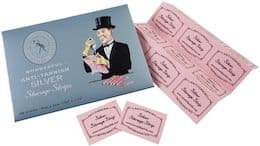
-----
UV light is tarnishing silver?
A. I know this is over 20 years later from the original question, but just today I was using a UV-C wand that I received to decontaminate my cell phone & remote, etc., and just on a whim I ran it across my hands despite the fact that I think it says on the packaging not to do that. But I thought I would be cute and kill the bacteria and germs on my hands and around my fingernails and now I just noticed that my silver wedding band now is discolored.
Didi Miller-Anders- Hartselle, Alabama
April 11, 2022
"To date it has generally been thought that metals are not light sensitive. Visible light is known to break down organic coatings and to accelerate the deterioration of showcase materials leading to enhanced off-gassing. Two mechanisms on silver have been studied. The patinas of some silver coins and medals are affected by visible light, with silver chloride converting to fine silver particles. The effect of light, UV light, temperature, RH, ethanoic acid, methanoic acid and methanal concentrations on the reaction have been investigated. In more polluted environments, silver tarnishes in a parabolic manner. The sulfide tarnish is protective to a certain degree. Light exposures above 350 lux have been shown to remove the protective effect of the tarnish."
A. www.english-heritage.org.uk/siteassets/home/learn/conservation/collections-advice--guidance/effects-of-light-on-silver-tarnishing.pdf
Hope it helps and good luck!
- Cerovski vrh
April 14, 2022
⇩ Related postings, oldest first ⇩
Q. Jaime, I am having a silver tarnishing problem with a lamp causing the brightness to go down. Does UV light have a tarnishing effect on silver? I know that sulfur
⇦ on
eBay
or
Amazon [affil link]
does. However, I have performed an EDS analysis on the tarnished surface and I could not detect any traces of sulfur.
How about polyester resins, do they have sulfur in it?
Houston, Texas
1999
A. Jaime, I do not think UV light is the problem with your silver tarnish. UV light can only accelerate chemical reactions but it is not a chemical itself. In addition to sulfur compounds, other chemicals also cause copper corrosion, such as ammonium, acid with oxygen, nitrogen oxide, and so on. It is not surprising to me that you did not detect sulfur on your tarnished silver surface. EDS analyzes about 1 micron depth of surface material and detection limit is about 0.5% a/a. Only single layer sulfur can lead to silver tarnish, which means sulfur content on the tarnished silver surface within one micron depth is much lower than the detection limit of EDS. I guess you can detect the existence of sulfur on your tarnished silver surface you do XPS or AES analysis which is truly surface analytical tool. Ling
Ling HaoMinden, Nevada
1999
Q. According to the lamp supplier, Because the failed lamp reflector has darkened (black) it seems it is burnt or tarnished but actually, it is discoloration of the silver. He further indicated that heat from the light source was the culprit to this discoloration. Is the discoloration mechanism a corrosion phenomenon or is it a burning phenomenon? What can I do to confirm failure mechanism?
Jaime LLinas [returning]Houston, Texas
1999
A. If it is burnt, the main component of the black stuff on silver surface should be silver oxide. If it is tarnished, the black stuff should be mainly silver sulfide. Surface analysis will provide you with answer. Visually, silver oxide is truly black, while silver sulfide is slightly greyish black.
Ling
Minden, Nevada
1999
Q, A, or Comment on THIS thread -or- Start a NEW Thread
